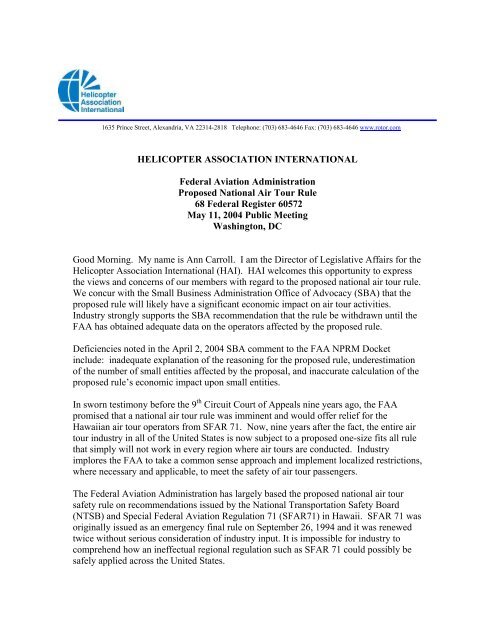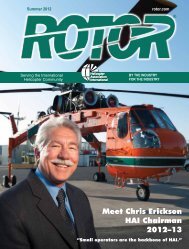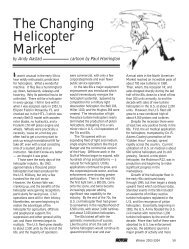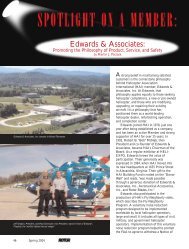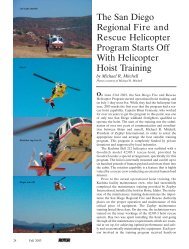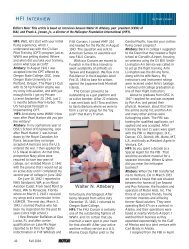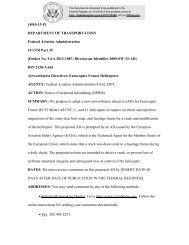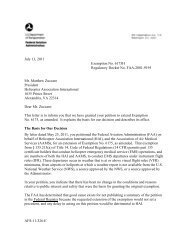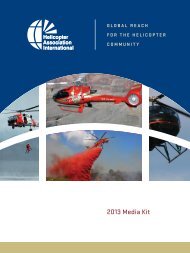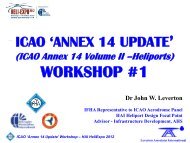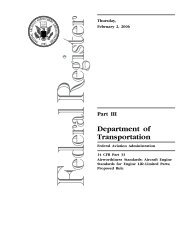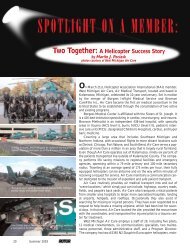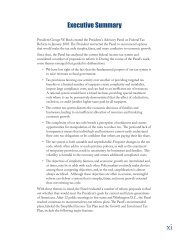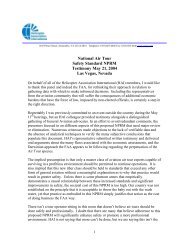testimony - Helicopter Association International
testimony - Helicopter Association International
testimony - Helicopter Association International
Create successful ePaper yourself
Turn your PDF publications into a flip-book with our unique Google optimized e-Paper software.
1635 Prince Street, Alexandria, VA 22314-2818 Telephone: (703) 683-4646 Fax: (703) 683-4646 www.rotor.com<br />
HELICOPTER ASSOCIATION INTERNATIONAL<br />
Federal Aviation Administration<br />
Proposed National Air Tour Rule<br />
68 Federal Register 60572<br />
May 11, 2004 Public Meeting<br />
Washington, DC<br />
Good Morning. My name is Ann Carroll. I am the Director of Legislative Affairs for the<br />
<strong>Helicopter</strong> <strong>Association</strong> <strong>International</strong> (HAI). HAI welcomes this opportunity to express<br />
the views and concerns of our members with regard to the proposed national air tour rule.<br />
We concur with the Small Business Administration Office of Advocacy (SBA) that the<br />
proposed rule will likely have a significant economic impact on air tour activities.<br />
Industry strongly supports the SBA recommendation that the rule be withdrawn until the<br />
FAA has obtained adequate data on the operators affected by the proposed rule.<br />
Deficiencies noted in the April 2, 2004 SBA comment to the FAA NPRM Docket<br />
include: inadequate explanation of the reasoning for the proposed rule, underestimation<br />
of the number of small entities affected by the proposal, and inaccurate calculation of the<br />
proposed rule’s economic impact upon small entities.<br />
In sworn <strong>testimony</strong> before the 9 th Circuit Court of Appeals nine years ago, the FAA<br />
promised that a national air tour rule was imminent and would offer relief for the<br />
Hawaiian air tour operators from SFAR 71. Now, nine years after the fact, the entire air<br />
tour industry in all of the United States is now subject to a proposed one-size fits all rule<br />
that simply will not work in every region where air tours are conducted. Industry<br />
implores the FAA to take a common sense approach and implement localized restrictions,<br />
where necessary and applicable, to meet the safety of air tour passengers.<br />
The Federal Aviation Administration has largely based the proposed national air tour<br />
safety rule on recommendations issued by the National Transportation Safety Board<br />
(NTSB) and Special Federal Aviation Regulation 71 (SFAR71) in Hawaii. SFAR 71 was<br />
originally issued as an emergency final rule on September 26, 1994 and it was renewed<br />
twice without serious consideration of industry input. It is impossible for industry to<br />
comprehend how an ineffectual regional regulation such as SFAR 71 could possibly be<br />
safely applied across the United States.
The NTSB and industry have failed to identify a reliable basis for the FAA’s conclusion<br />
that SFAR 71 resulted in a decrease in air tour accidents in Hawaii. No reliable basis was<br />
identified by the NTSB or the SBA for the FAA’s conclusion since no accurate,<br />
verifiable FAA method of collecting and tracking flight activity data for specific<br />
segments of nonscheduled Part 135 flight operations exists. Clearly, this substantiates<br />
industry’s assertion that the FAA is unaware of the number of operators affected by the<br />
proposal. The SBA recommended that the FAA clarify whether higher accident rates,<br />
differences in data, or other changed circumstances, even warrant new rules<br />
An analysis of accident statistics in Hawaii by aviation consultants, Conklin and de<br />
Decker, confirmed that the 1,500-foot altitude restrictions within SFAR 71 did not<br />
accomplish the intended result of reducing accidents and injuries due to a loss of power<br />
in cruise. Moreover, many HAI members conducting sightseeing operations in Hawaii<br />
contend that the rule does more harm than good from a safety standpoint. Industry<br />
believes that the Hawaiian accident reductions are due to vastly improved engine<br />
technology, increased training, the adoption of voluntary in-house safety programs and<br />
the creation of TOPS, a professional air tour safety organization.<br />
The NTSB clearly cautioned the FAA to improve the methods it uses to estimate<br />
nonscheduled Part 135 activity, noting that a revision may not be considered an<br />
improvement unless it is validated against some known information. On numerous<br />
occasions, the Safety Board has recommended to the FAA that nonscheduled Part 135<br />
operators be required to report revenue flight-hour activity, at least annually. Without an<br />
accurate, verifiable activity measure, such as data reported from nonscheduled Part 135<br />
operators or a full census survey, neither the FAA nor the Safety Board can calculate<br />
safety data for the various segments that comprise nonscheduled Part 135 operations<br />
(e.g., passenger, air cargo, air ambulance).<br />
The FAA recently began a comprehensive regulatory review of 14 CFR Parts 135. In<br />
August of 2003, the NTSB issued Safety Recommendations A-03-37 through 39 to the<br />
FAA, suggesting that the Part 135/125 Aviation Rulemaking Committee offered a timely<br />
opportunity for the FAA to address both the need and the method for more accurate flight<br />
activity estimates for nonscheduled Part 135 operations. The FAA should adhere to the<br />
recommendation offered by the SBA, withdraw the proposed rule, and immediately<br />
convene an Aviation Rulemaking Committee (ARC) or Aviation Rule Advisory<br />
Committee (ARAC). Modification to applicable sections of Part 135 or the adoption of<br />
operations specs to conform to the safety needs of specific regions is preferred over the<br />
creation of new more stringent regulations.<br />
While the FAA recognized some economic impact upon Part 91 and existing Part 135<br />
operators, industry and the SBA believe the estimates to be too low. The NPRM failed to<br />
even consider costs associated with additional insurance requirements for new Part 135<br />
operations and lost business opportunities for operators awaiting certification once the<br />
Part 119 six-month exemption expires. Implementation of this rule is likely to cost<br />
commercial air tour companies nearly $4 million dollars for new and unnecessary<br />
equipment purchases, labor costs, and lost revenue due to decreased passenger-carrying<br />
2
capability. Clearly, there is no recognition of other business sectors such as<br />
manufacturing and maintenance repair stations that would be affected. The air tour<br />
industry is largely comprised of small business operations, and many of the costs<br />
associated with this rule simply cannot be absorbed by any segment of the sightseeing<br />
and air tour industry.<br />
There is no significant accounting in the NPRM for the economic repercussions from lost<br />
business opportunities due to the overly restrictive weather criteria that would be imposed<br />
under this proposed rule, nor an FAA accounting of increased budgetary burdens that<br />
would befall the agency in processing additional Part 135 certificates, much less the<br />
number of enforcement inspectors that would be required.<br />
Thus, an extensive and thorough scientific analysis of this issue is needed, taking into<br />
consideration the unique design characteristics of helicopters. Final approval of this<br />
proposed rule without significant changes would effectively shut down a major portion of<br />
the commercial helicopter sightseeing industry and deprive the public of a service that is<br />
needed and enjoyed by hundreds of thousands of passengers.<br />
Unless the FAA is willing to undertake an objective analysis of this rule from a true<br />
safety perspective, this is nothing but the appearance of yet another layer of federal<br />
regulations. The majority of commercial air tours are conducted over national parks.<br />
Congress has already mandated that air tour management plans be developed, SFAR 50-2<br />
already exists in the Grand Canyon, and no consideration has ever been given to revising<br />
SFAR 71 in Hawaii.<br />
The government should be actively trying to create new jobs, not eliminate them. This<br />
proposed rule will result in operators and manufacturers laying off employees and<br />
shutting down businesses that are vital to our economy. The helicopter sightseeing<br />
business flies in hundreds of thousands of international tourists each year, and a<br />
helicopter sightseeing tour is the only opportunity for some to enjoy the scenic beauty of<br />
our great country. Is the FAA willing to drive 1,000 or more small companies out of<br />
business by way of a hastily issued and ill-conceived rule that evolved from a noise<br />
abatement restriction?<br />
1635 Prince Street, Alexandria, VA 22314-2818 Telephone: (703) 683-4646 Fax: (703) 683-4646 www.rotor.com<br />
3


